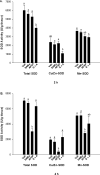Novel protective mechanisms for S-adenosyl-L-methionine against acetaminophen hepatotoxicity: improvement of key antioxidant enzymatic function
- PMID: 22683606
- PMCID: PMC3398222
- DOI: 10.1016/j.toxlet.2012.05.018
Novel protective mechanisms for S-adenosyl-L-methionine against acetaminophen hepatotoxicity: improvement of key antioxidant enzymatic function
Abstract
Acetaminophen (APAP) overdose leads to severe hepatotoxicity, increased oxidative stress and mitochondrial dysfunction. S-adenosyl-L-methionine (SAMe) protects against APAP toxicity at a mmol/kg equivalent dose to N-acetylcysteine (NAC). SAMe acts as a principle biological methyl donor and participates in polyamine synthesis which increase cell growth and has a role in mitochondrial protection. The purpose of the current study tested the hypothesis that SAMe protects against APAP toxicity by maintaining critical antioxidant enzymes and markers of oxidative stress. Male C57Bl/6 mice were treated with vehicle (Veh; water 15 ml/kg, ip), SAMe (1.25 mmol/kg, ip), APAP (250 mg/kg, ip), and SAMe+APAP (SAMe given 1 h following APAP). Liver was collected 2 and 4 h following APAP administration; mitochondrial swelling as well as hepatic catalase, glutathione peroxidase (GPx), glutathione reductase, and both Mn- and Cu/Zn-superoxide dismutase (SOD) enzyme activity were evaluated. Mitochondrial protein carbonyl, 3-nitrotyrosine cytochrome c leakage were analyzed by Western blot. SAMe significantly increased SOD, GPx, and glutathione reductase activity at 4 h following APAP overdose. SAMe greatly reduced markers of oxidative stress and cytochrome C leakage following APAP overdose. Our studies also demonstrate that a 1.25 mmol/kg dose of SAMe does not inhibit CYP 2E1 enzyme activity. The current study identifies a plausible mechanism for the decreased oxidative stress observed when SAMe is given following APAP.
Copyright © 2012 Elsevier Ireland Ltd. All rights reserved.
Figures









Similar articles
-
S-adenosyl-l-methionine protection of acetaminophen mediated oxidative stress and identification of hepatic 4-hydroxynonenal protein adducts by mass spectrometry.Toxicol Appl Pharmacol. 2014 Dec 1;281(2):174-84. doi: 10.1016/j.taap.2014.08.027. Epub 2014 Sep 22. Toxicol Appl Pharmacol. 2014. PMID: 25246065 Free PMC article.
-
Comparison of S-adenosyl-L-methionine (SAMe) and N-acetylcysteine (NAC) protective effects on hepatic damage when administered after acetaminophen overdose.Toxicology. 2008 Feb 3;244(1):25-34. doi: 10.1016/j.tox.2007.10.027. Epub 2007 Nov 7. Toxicology. 2008. PMID: 18068290 Free PMC article.
-
Comparison of S-Adenosyl-L-methionine and N-acetylcysteine protective effects on acetaminophen hepatic toxicity.J Pharmacol Exp Ther. 2007 Jan;320(1):99-107. doi: 10.1124/jpet.106.111872. Epub 2006 Oct 25. J Pharmacol Exp Ther. 2007. PMID: 17065366
-
Central Mechanisms of Acetaminophen Hepatotoxicity: Mitochondrial Dysfunction by Protein Adducts and Oxidant Stress.Drug Metab Dispos. 2024 Jul 16;52(8):712-721. doi: 10.1124/dmd.123.001279. Drug Metab Dispos. 2024. PMID: 37567742 Free PMC article. Review.
-
Autophagy and acetaminophen-induced hepatotoxicity.Arch Toxicol. 2018 Jul;92(7):2153-2161. doi: 10.1007/s00204-018-2237-5. Epub 2018 Jun 6. Arch Toxicol. 2018. PMID: 29876591 Review.
Cited by
-
Metabolic characterization and pathway analysis of berberine protects against prostate cancer.Oncotarget. 2017 Apr 28;8(39):65022-65041. doi: 10.18632/oncotarget.17531. eCollection 2017 Sep 12. Oncotarget. 2017. PMID: 29029409 Free PMC article.
-
Salvianolic Acid C against Acetaminophen-Induced Acute Liver Injury by Attenuating Inflammation, Oxidative Stress, and Apoptosis through Inhibition of the Keap1/Nrf2/HO-1 Signaling.Oxid Med Cell Longev. 2019 May 12;2019:9056845. doi: 10.1155/2019/9056845. eCollection 2019. Oxid Med Cell Longev. 2019. PMID: 31214283 Free PMC article.
-
Sanghuangporus sanghuang Mycelium Prevents Paracetamol-Induced Hepatotoxicity through Regulating the MAPK/NF-κB, Keap1/Nrf2/HO-1, TLR4/PI3K/Akt, and CaMKKβ/LKB1/AMPK Pathways and Suppressing Oxidative Stress and Inflammation.Antioxidants (Basel). 2021 Jun 2;10(6):897. doi: 10.3390/antiox10060897. Antioxidants (Basel). 2021. PMID: 34199606 Free PMC article.
-
Dietary α-Mangostin Provides Protective Effects against Acetaminophen-Induced Hepatotoxicity in Mice via Akt/mTOR-Mediated Inhibition of Autophagy and Apoptosis.Int J Mol Sci. 2018 May 1;19(5):1335. doi: 10.3390/ijms19051335. Int J Mol Sci. 2018. PMID: 29723988 Free PMC article.
-
Recombinant human soluble thrombomodulin ameliorates acetaminophen-induced liver toxicity in mice.Exp Ther Med. 2019 Aug;18(2):1323-1330. doi: 10.3892/etm.2019.7665. Epub 2019 Jun 11. Exp Ther Med. 2019. PMID: 31316624 Free PMC article.
References
-
- Adamson GM, Harman AW. A role for the glutathione peroxidase/reductase enzyme system in the protection from paracetamol toxicity in isolated mouse hepatocytes. Biochem Pharmacol. 1989;38:3323–3330. - PubMed
-
- Andersson BS, Rundgren M, Nelson SD, Harder S. N-acetyl-p-benzoquinone imine-induced changes in the energy metabolism in hepatocytes. Chem Biol Interact. 1990;75:201–211. - PubMed
-
- Anundi I, Lahteenmaki T, Rundgren M, Moldeus P, Lindros KO. Zonation of acetaminophen metabolism and cytochrome P450 2E1-mediated toxicity studied in isolated periportal and perivenous hepatocytes. Biochem Pharmacol. 1993;45:1251–1259. - PubMed
-
- Bailey SM, Robinson G, Pinner A, Chamlee L, Ulasova E, Pompilius M, Page GP, Chhieng D, Jhala N, Landar A, Kharbanda KK, Ballinger S, Darley-Usmar V. S-adenosylmethionine prevents chronic alcohol-induced mitochondrial dysfunction in the rat liver. Am J Physiol Gastrointest Liver Physiol. 2006;291:G857–867. - PubMed
Publication types
MeSH terms
Substances
Grants and funding
LinkOut - more resources
Full Text Sources
Other Literature Sources
Medical

